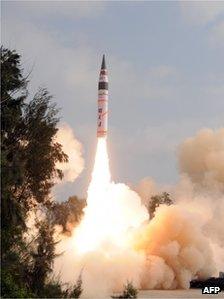The 'missile woman' behind India's new ICBM
- Published

Ms Thomas says she has never experienced gender discrimination at work
The media loves calling her Missile Woman - and with good reason.
Tessy Thomas, a scientist from India's Defence Research and Development Organisation (DRDO), is a rare woman who has played a key role in the making of its most potent long-range nuclear-capable ballistic missile, the Agni-V, which was successfully tested on Thursday.
She is thought to be one of the very few women working on strategic nuclear ballistic missiles in the world.
In the male-dominated world of the country's highly secretive missile development programme, Ms Thomas, 49, has stood out ever since she joined the DRDO in 1988.
But the charismatic scientist says she has never faced any anti-female bias at her workplace.
"There is no gender discrimination in technology. If your work is good it automatically stands out. I have never faced any discrimination ever in my workplace," she says.
Ms Thomas, a Roman Catholic, was born to a small-businessman father and a homemaker mother in Alleppey in southern Kerala state.
She grew up near a rocket launching station and says her fascination with rockets and missiles began then.
After finishing school and college in Kerala, she left the state for the first time at the age of 20 to pursue a masters degree in guided missiles in the western Indian city of Pune. It was there she met her future husband, Saroj Kumar, now a commodore in the Indian navy.
Ms Thomas says she was named after Mother Teresa, the late Nobel laureate who worked with the poor in Calcutta.
'Weapons of peace'
So how does she feel about about working on some of the most powerful weapons of mass destruction?
Ms Thomas says she is developing "what are really weapons of peace".
What has been infinitely more difficult, she says, is juggling work and family.
At times, she says, she is torn between her loyalties to the missile programme and her family responsibilities.
It has helped immensely, she believes, that she has had immense support from her husband and son, Tejas, an engineering student who shares his name with India's indigenously developed light combat aircraft, also made by the DRDO.
In a glowing tribute in 2008, The Indian Woman Scientists Association did not forget to mention that "like most women she also does a tight-rope walk between home and career, between being a mother and a scientist who is dedicated to her job.

Ms Thomas has played an important role in developing the Agni-V
"We feel Tessy Thomas serves as a role model and an inspiration for women scientists to achieve their dreams and have their feet planted in both worlds successfully," the group said.
Ms Thomas has said when she joined the DRDO there were very few women working there. Now there are many more working in key weapons programmes.
In January, Prime Minister Manmohan Singh told the Indian Science Congress that Ms Thomas is an example of a "woman making her mark in a traditionally male bastion and decisively breaking the glass ceiling".
Last year, three women scientists won the Shanti Swarup Bhatnagar award, India's top science prize, compared to 11 from 1958-2010.
Now, the accolades are again coming fast for Ms Thomas - the media also love to call her <italic>Agniputri</italic>, or one born of fire, after the missiles she has helped develop.
"We are all proud of our country. Agni-V is one of our greatest achievements," she says.
<italic>Pallava Bagla is a correspondent for Science magazine and science editor for New Delhi Television (NDTV).</italic>
- Published19 April 2012
- Published19 April 2012